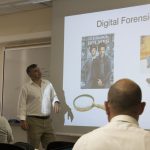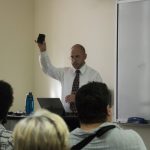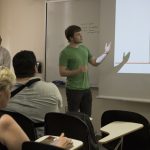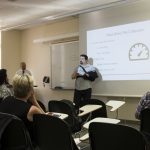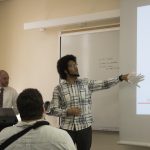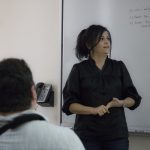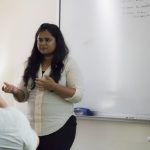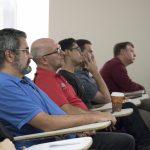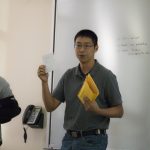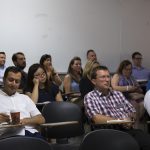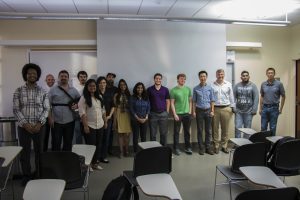 On August 7, 2017, the CI Computer Science students presented a prototype of a digital forensic tool, which we named SEAKER (Storage Evaluator and Knowledge Extraction Reader), as part of their Masters COMP 524 Cybersecurity course. This project was a collaboration between the Ventura County District Attorney (VCDA) Digital Forensics Lab and CI Computer Science, under the umbrella of the SoCal High Technology Task Force (HTTF).
On August 7, 2017, the CI Computer Science students presented a prototype of a digital forensic tool, which we named SEAKER (Storage Evaluator and Knowledge Extraction Reader), as part of their Masters COMP 524 Cybersecurity course. This project was a collaboration between the Ventura County District Attorney (VCDA) Digital Forensics Lab and CI Computer Science, under the umbrella of the SoCal High Technology Task Force (HTTF).
The students presented a live demo with devices supplied by the Ventura County DA. The SEAKER prototype was able to compile search results in less than a minute depending on the size of the device. According to VCDA officials at the presentation this is a remarkable increase in efficiency and will be a useful tool in the field: while imaging of a hd can take up to 4 hours, SEAKER performs a triage search in minutes.
Digital Forensics (DF) deals with the recovery and investigation of clues from digital devices (computers, handhelds, iPads, routers, modems, DVRs, etc.). The goal of this effort is to support or refute a hypothesis in court. DF is a complex and technical field: it can be used to attribute evidence to specific suspects, confirm alibis or statements, determine intent, identify sources, or authenticate documents.
A DF investigation commonly consists of 3 stages: acquisition or imaging of exhibits, analysis and reporting. The SEAKER tool helps with the acquisition of data from digital devices in a way that prevents tampering.
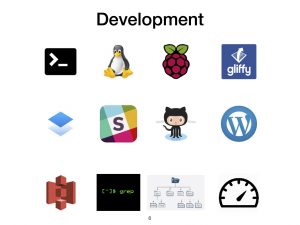 The SEAKER project was a fantastic learning experience for our students, as its design and prototyping combined many different skills: The C programming language, BASH shell scripting, the Linux Operating Systems and command line, the Raspberry Pi hardware, Gliffy diagrams, Dropbox Paper (which we used as a Wiki); Slack collaborative discussion / brainstorming tool, the GitHub software repository which was used as a collaborative tool in the design of the software that animated the Raspberry Pi, WordPress blogging, AWS S3 which served as a repository of the final product, Grep (regular expressions and pattern matching), working with different file systems, and of course strict performance (speed, read only). All of this had to be combined by a group of 18 students, with different backgrounds and skill sets to produce something that could be used by DF examiners.
The SEAKER project was a fantastic learning experience for our students, as its design and prototyping combined many different skills: The C programming language, BASH shell scripting, the Linux Operating Systems and command line, the Raspberry Pi hardware, Gliffy diagrams, Dropbox Paper (which we used as a Wiki); Slack collaborative discussion / brainstorming tool, the GitHub software repository which was used as a collaborative tool in the design of the software that animated the Raspberry Pi, WordPress blogging, AWS S3 which served as a repository of the final product, Grep (regular expressions and pattern matching), working with different file systems, and of course strict performance (speed, read only). All of this had to be combined by a group of 18 students, with different backgrounds and skill sets to produce something that could be used by DF examiners.
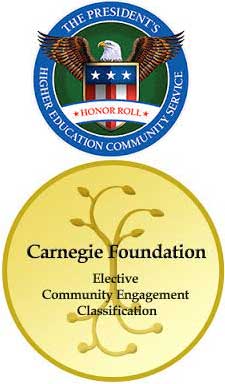 One of the CI pillars is Community Engagement and Service Learning. This approach identifies needs in the community, and builds a curriculum around research and development to address those needs. The SEAKER project is a great example of such a symbiotic relation between CI and the community. Also, it is an example of the strength of a pedagogical approach that combines both theory and practice. Without theory a field becomes a collection of ad hoc procedures. But without practice theory becomes an abstract exercise in intellectual virtuosity. We plan to build on the approach that combines the Service Learning and Theory & Practice paradigms as we go forward with our Computer Science program in Security Systems Engineering and our Masters level offering in Cybersecurity.
One of the CI pillars is Community Engagement and Service Learning. This approach identifies needs in the community, and builds a curriculum around research and development to address those needs. The SEAKER project is a great example of such a symbiotic relation between CI and the community. Also, it is an example of the strength of a pedagogical approach that combines both theory and practice. Without theory a field becomes a collection of ad hoc procedures. But without practice theory becomes an abstract exercise in intellectual virtuosity. We plan to build on the approach that combines the Service Learning and Theory & Practice paradigms as we go forward with our Computer Science program in Security Systems Engineering and our Masters level offering in Cybersecurity.
Some photos from the event:
